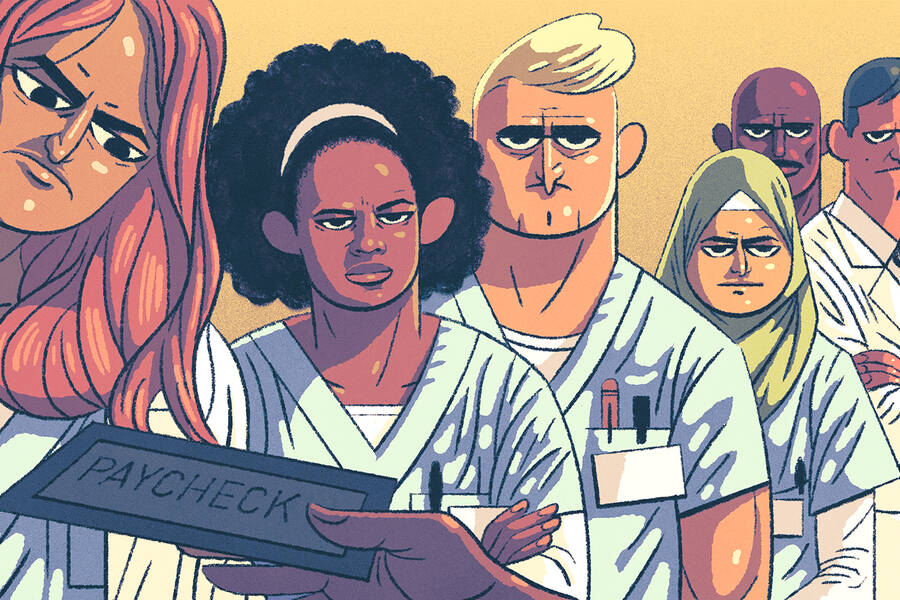
Yevgenia Nayberg
The U.S. is one of the only wealthy countries that requires people receiving food stamps or similar benefits to work in order to continue to qualify for the aid program.
“The U.S. is quite unusual in how much it relies on work incentives for programs that in other countries would just be pure social safety net or welfare programs,” says Elena Prager, an associate professor of strategy at the Kellogg School. “The policy motivation is that it’s better to teach someone to fish than to just give them a fish.”
But there’s a problem with that rationale, and it’s a big one: we don’t know if the work requirement actually works. It’s not clear to what degree the requirements increase economic self-sufficiency versus screening out vulnerable individuals who need the support but may not be able to sustain employment.
The question has taken on additional urgency during the COVID-19 pandemic. The work requirements for able-bodied adults associated with the U.S.’s Supplemental Nutrition Assistance Program (SNAP) were suspended on April 1 because of ballooning unemployment.
Reinstatement of the requirements has become a hotly debated, partisan policy issue at the federal and state levels. The Trump administration and other Republicans prefer reinstating these rules, whereas their Democratic counterparts disagree.
It’s a critical issue, as SNAP enrollment has risen significantly during the pandemic. The public-aid program, administered by the USDA, was already among the country’s largest poverty-alleviation programs. In 2015, for example, it provided benefits to over 45 million people, or 14 percent of the population.
To understand the effectiveness of work requirements, Prager and her colleagues studied a previous period during which the work requirements were temporarily lifted: while the country recovered from the Great Recession. They tracked able-bodied SNAP beneficiaries from Virginia who enrolled while the work requirements were temporarily lifted and then tracked how those beneficiaries fared once the requirements were reinstated in 2013.
They found that the reinstatement of the requirements caused a much larger proportion of beneficiaries to leave SNAP than previously estimated. Additionally, the requirements did not significantly incentivize employment or earnings for the majority of beneficiaries.
Prager hopes today’s policymakers take note. “Understanding whether the work requirement does what it’s supposed to is especially urgent in the wake of COVID and the big recession it has caused,” she says.
A Challenging Research Problem
SNAP is designed to help very low-income households afford food. Those enrolled get money loaded onto a debit card, which they can use to buy certain types of groceries and minimally prepared foods. Benefit amounts have varied over time and are based on income, but do not exceed $200 a month per person.
The program has included work requirements since 1996. This means that all able-bodied adults ages 18–49 without dependents must be employed or engaged in community service at least 80 hours a month to secure ongoing benefits. If they fail to meet the requirement, they can only receive SNAP for three months in a three-year period.
Prager and colleagues, Colin Gray at Wayfair, Adam Leive at the University of Virginia, Kelsey Pukelis at Harvard University, and Mary Zaki at the University of Maryland, aren’t the first to conduct research into the effectiveness of this type of work requirement. But past studies have faced a key challenge. “It’s hard to understand what would happen to potential program beneficiaries in a world where work requirements didn’t exist because those requirements do exist,” Prager says.
To get around that challenge, past researchers have tried to determine the types of people they thought would be on SNAP but weren’t, and they then modeled how work requirements affect such groups. But that’s not an ideal solution, as Prager notes: “It’s creating a hypothetical scenario that simply doesn’t exist.”
Complicating matters, researchers have struggled to gain access to actual SNAP program data. So they’ve often tried to measure program participation from national survey data (such as from the Census Bureau’s American Community Survey), which tend to underreport social-welfare participation due to stigma and other factors.
Fortunately for this new study, Virginia recently made SNAP and employment data available as part of a general campaign to improve their government-data infrastructure. And, importantly, the data included a time when there was no SNAP work requirement for participants: after the Great Recession, from 2009 to 2013, when few jobs were available.
This provided an unprecedented window into the actual effects of SNAP work requirements.
A Troublesome Cost–Benefit
The research hinged on the idea that people who ordinarily wouldn’t be eligible for SNAP or would not bother to apply—those who didn’t feel they could meet the work requirement, for example—could enroll while the requirements were lifted.
“If we, as a society, think it’s important to provide basic nutrition to people who can’t work, at the risk of potentially giving some of that spending to people who ‘choose’ not to work, then work requirements probably aren’t consistent with that set of priorities.”
— Elena Prager
The study focused specifically on enrolled able-bodied adults without dependents. “We can follow those people forward in the data to see what happens to them once the requirements are reinstated,” Prager says.
The researchers first examined the extent to which the requirements caused Virginia SNAP beneficiaries in their sample to leave the program after work requirements were reinstated in October 2013.
The researchers estimate a 24 percent attrition rate due to work requirements alone, which is about double the 10–15 percent rates estimated in past work. “That’s a much larger decline than anything previously documented,” she says.
In short, the work requirements likely made a lot of people lose benefits.
Still, that might be a reasonable outcome if the requirements have their intended effect of nudging people into the workforce and motivating them to earn more. While past research has found little benefit from work requirements, advocates of the requirements argue those studies are inconclusive due to their data limitations.
Using their newly available dataset, Prager and her coauthors found that work requirements did not have a large impact on earnings or employment. Though the requirements appeared to improve earnings for a small subset of SNAP users, there was no statistically significant impact on employment.
The research also pointed to one group for whom the requirements had particularly damaging effects: the homeless. Prager says, “We found the most disproportionate exit from the program was among homeless beneficiaries, who face structural barriers to work such as not having a permanent mailing address,” she says.
A Question of Values
It might be tempting to conclude from these findings that the SNAP work requirements are simply bad policy—they prevent people from accessing needed benefits without motivating beneficiaries to find work.
But it’s not so simple, Prager explains.
“What we found isn’t sufficient to objectively say that work requirements are a bad idea,” she says. “We can say that the number of people who lose access to benefits is large—about twice what was previously estimated—and for the majority of beneficiaries we fail to find improvement in employment. But there might be a small group who actually earn more due to the requirements.”
Exactly what to do with the SNAP requirements, then, may be less of an economic question and more one of values. “If we, as a society, think it’s important to provide basic nutrition to people who can’t work, at the risk of potentially giving some of that spending to people who ‘choose’ not to work, then work requirements probably aren’t consistent with that set of priorities,” Prager says.
If, on the other hand, the goal is to ensure that no public funds are spent on someone who’s likely able to work but doesn’t, then it’s a good argument to uphold the requirements.
Those values-driven decisions will be especially important today. Short-term unemployment figures during the pandemic have been significantly worse than in the post-Recession period Prager studied. That trend is likely to continue.
The study’s results, then, provide only a “best-case” scenario, Prager says, as people would have even more trouble meeting SNAP-related and other social-program work requirements in the COVID economy, likely resulting in many who need support going without it.
“It would be a lot worse to have those requirements in place now,” Prager says, “both in terms of how many people would lose their benefits and the inability of people to overcome basic labor-market fundamentals to work more.”



